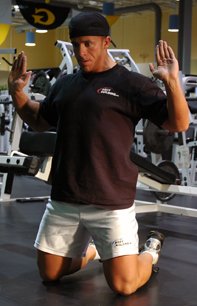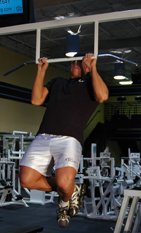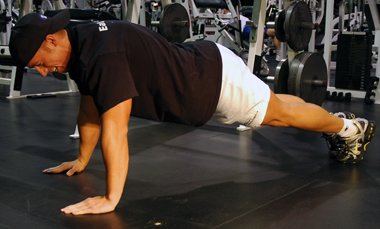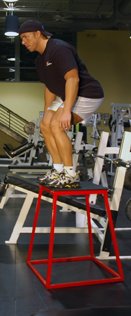The Thai Boxing Workout: A Scientific Approach
Researched and written by Tim Mousel
Description of Thai Boxing
 Thai Boxing, the national sport of Thailand, also known as Muay Thai, is perhaps the most brutal sport in existence. Participants batter each other with punches, kicks, knees and elbows. There are few rules in Thai Boxing and boils down to survival of the fittest. A match consists of five, three minute rounds. Punching, knee and elbow strikes and kicking techniques are allowed to any part of the body, except the groin. Because of the hard, fast paced action, it is very important for the fighters to be highly conditioned, both physically and mentally. A fighter entering the ring in anything but top condition can expect, at the very least, to be knocked unconscious. There is also a chance of death if not properly prepared. In Thailand, there are many deaths each year as a result of the beating taken in the ring.
Thai Boxing, the national sport of Thailand, also known as Muay Thai, is perhaps the most brutal sport in existence. Participants batter each other with punches, kicks, knees and elbows. There are few rules in Thai Boxing and boils down to survival of the fittest. A match consists of five, three minute rounds. Punching, knee and elbow strikes and kicking techniques are allowed to any part of the body, except the groin. Because of the hard, fast paced action, it is very important for the fighters to be highly conditioned, both physically and mentally. A fighter entering the ring in anything but top condition can expect, at the very least, to be knocked unconscious. There is also a chance of death if not properly prepared. In Thailand, there are many deaths each year as a result of the beating taken in the ring.
 Much of the Thai boxers' conditioning is done on the Thai pads. Thai pads are solid, heavy pads strapped to the arms of a holder. This method of training is advantageous to the heavy bag in that it allows the fighter to respond to a "live" opponent. The holders job varies, depending on the desired results of the training session. For some drills, the holder attacks with kicks to the legs, body or head, and punches to the body and head. While defending himself, the fighter throws his own kicks, knees and elbows. Using another method, the holder remains relatively stationary and allows the fighter to attack with a pre-designated combination or a free flow barrage of kicks, knees, and elbows.
Much of the Thai boxers' conditioning is done on the Thai pads. Thai pads are solid, heavy pads strapped to the arms of a holder. This method of training is advantageous to the heavy bag in that it allows the fighter to respond to a "live" opponent. The holders job varies, depending on the desired results of the training session. For some drills, the holder attacks with kicks to the legs, body or head, and punches to the body and head. While defending himself, the fighter throws his own kicks, knees and elbows. Using another method, the holder remains relatively stationary and allows the fighter to attack with a pre-designated combination or a free flow barrage of kicks, knees, and elbows.
Physical Training
 Proper structure to the training session is an important pre-requisite to obtaining desirable results. When designing a workout, it is necessary to identify which energy systems are used in the activity. Based on the systems used, training time can be devoted to improvement of that system. It is also important to identify the initial fitness level of the participant, the intensity of the activity, frequency, duration, and the method of training to be used.
Proper structure to the training session is an important pre-requisite to obtaining desirable results. When designing a workout, it is necessary to identify which energy systems are used in the activity. Based on the systems used, training time can be devoted to improvement of that system. It is also important to identify the initial fitness level of the participant, the intensity of the activity, frequency, duration, and the method of training to be used.
Energy Systems
Based on duration and intensity of the activity, four predominant energy pathways have been identified in Thaiboxing and any sport. The systems identified are the ATP, ATP-CP, Lactic Acid and the Aerobic-oxidative system. A basic understanding of these systems is helpful in understanding the design of the workouts.
ATP System
ATP (adenosine triphosphate) is the immediate source of energy for muscular contraction. There are two pathways through which it is formed: the aerobic pathway and the anaerobic pathway. The aerobic pathway requires oxygen to be present and utilizes fat, protein and carbohydrates (glucose, glycogen) to resynthesize ATP. When movement is very quick and explosive, there is not enough time for oxygen to be delivered to the contracting muscles. This is where the anaerobic pathway is called into action. The anaerobic pathway does not require oxygen and uses only carbohydrates to produce ATP. There is enough ATP stored in muscle to last for only three seconds of contraction.
ATP-CP System
When ATP is broken down and the energy is released, ADP (adenosine diphosphate) and P (phosphate) are formed. Another important source of energy is CP (creatine phosphate). CP cannot be used directly by the muscle, so it interacts with ADP and CP to re-form ATP. There is not a lot of CP available to the muscle so it too must be continually resynthesized. The ATP-CP system can supply enough energy to last for eight seconds of intense exercise.
Lactic Acid System
When intense activity is continued for about ninety seconds, glycogen is used as an energy source. When the glycogen is broken down, more ATP is produced. However, if the activity is intense (anaerobic), there will not be enough oxygen supplied to the muscles. When glycogen is burned in the absence of oxygen, lactic acid is produced. Once lactic acid is formed, it diffuses into the blood and is transported to different areas of the body. This allows the working muscle to continue. Eventually, the lactic acid level will accumulate to a level that will slow down thebiochemical reactions that lead to the production of ATP. Accumulation of lactic acid causes pain and burning sensations in the stressed muscles. Shortly thereafter, contraction will not be able to take place.
Aerobic-Oxidative System
If this intense activity is to continue, the body will shift into the aerobic-oxidative system. The body will need an increased oxygen supply. This extra oxygen will be available only if the intensity of the activity is decreased. This higher oxygen consumption converts the lactic acid to pyruvate, which converts to carbon dioxide and water and is dispelled from the lungs. Pyruvate is a product of burned glycogen. If pyruvate is formed in the absence of oxygen, lactic acid formation will be the result. The system will then shift back into the anaerobic systems.
Recovery of the Anaerobic Systems (Rest)
During the recovery period of training, the ATP-CP must be built-up and replenished and the accumulated lactic acid must be removed. If these needs aren't met, the systems will be un- available for further activity. While resting after an anaerobic work bout, oxygen consumption is increased because of the increased depth and rate of breathing. This extra oxygen turns the lactic acid back to pyruvic acid and within 20 seconds, 50% of the ATP and CP is restored, in 40 seconds, 75% is restored and in 60 seconds, 87% is restored. Almost all of the ATP and CPare replenished within three minutes. The removal rate of lactic acid is slower then the rebuilding rate of ATP and CP. In 25 minutes, 50% of the lactic acid will be removed, in 50 minutes, 75% and 87% in 75 minutes. The removal rate of lactic acid can be sped up through light activity performed during the recovery period. This is because some of the lactic acid is metabolized aerobically during the light activity.
Work/Rest Ratio
The rest interval is very important. The work rest ratio in Appendix A has been designed according to physiological guidelines. If the rest period is too brief, the ATP and CP will not be sufficiently replenished and the accumulated lactic acid will not be adequately removed. The next bout of exercise would have to be performed at a lower intensity. If the rest period is too long, the body will recover and the training effect will be lost.
Pre-Program Information
To obtain desired results, it is important to train at the proper intensity (degree of overload). The intensity of an activity is dependent upon many factors, mainly the goals of the participant. If the goal is health-related fitness, the intensity does not need to be as high as an athletes intensity whoset a goal of increased performance. Both individuals need to monitor their workload through heart rate (HR) to determine and work at the optimal intensity.
Determination of Resting Heart Rate
The first step is to determine the resting heart rate (RHR). The best results are obtained early in the morning immediately upon awakening. A reliable RHR is obtained by averaging the results of three mornings in a row. The HR may be taken by placing fingers on the carotid artery on the side of the neck, the temporal artery in front of the ear (temple) or at the radial artery at the base of the thumb. A good estimation of the HR is to count the pulse for 10 or 15 seconds and multiply by 6 or 4, respectively. This will give the HR in beats per minute (bpm). If the pulse was counted 18 times in 15 seconds, the RHR is 72 bpm (18x4=72 bpm).
Determination of Maximum Heart Rate
The maximum heart rate (MHR) is needed to calculate the HR at which the workload should be performed. The direct method of determining MHR is to monitor the HR of a subject running to exhaustion on a treadmill. An easier way is to subtract age from 220. A 20 year old athlete will have a MHR of 200 bpm (220- 20=200).
Determination of Training Heart Rate
The training heart rate (THR) is the HR at which the workload should be performed to obtain a desired physiological response. The desired percentage of MHR is multiplied by MHR to determine the THR. If the same 20 year old athlete is to perform a workout that calls for an intensity at 70% of MHR, the THR would be 140 bpm (200x.70=140 bpm).
Training Intensity and Frequency
For a training effect to occur, the appropriate overload must be placed on the targeted system. The aerobic system needs to be trained at 60-90% of MHR for a training effect to occur. Healthy, sedentary individuals should start at the lower end (60%) and gradually build up over time. Trained aerobic athletes should train near the upper end (90%). The anaerobic systems need to be trained at 90-100% of MHR. How often should the systems be overloaded? Research shows that 3 days per week is the minimum for aerobic training. Moderately trained individuals should train 3-5 days per week while highly trained athletes can train 5-7 days per week. The anaerobic systems need a minimum of 3 days per week and can be trained on the same days as the aerobic system. It is recommended that the anaerobic work precedes the aerobic training. Other days can be spent developing skill and techniques.
Warm-Up Equipment Needed:
Thai pads and a stop watch (Modern sport watches with a repeat timer work very well). Warming-up is important to physically and psychologically prepare the participant for the increased demands about to be placed on the body. There are two types of warm-up: General and Specific. General warm-up consists of calisthenics, stretching and non-sport specific activity. Specific warm-up is performing the actual activity itself in a light, easy manner. The warm-up listed in Appendix B (below) is a specific warm-up. It begins with a 4 minute round of round kicks on the Thai pads. The 4 minute rest interval should be spent stretching or holding the pads for the previous holder. Workouts are ideally started and finished by one individual before holding for the partner. At completion of the 4 minute rest period, a 2 minute round of Form is done. Kicks, knees and elbows are thrown light and easy. The emphasis is on proper form. The two minute rest prepares the body for Accelerations. Accelerations help prepare the body for high intensity work. Each round lasts 16 seconds. The first 8 seconds is done at an easy pace and the last 8 seconds is done at full speed. Two consecutive kicks are thrown with the same leg before switching. The rest period is 24 seconds between each of the 4 rounds. A one minute rest is given prior to the Gutbuster rounds. Gutbusters consist of 4 rounds lasting 10 seconds each. one kick per side is thrown at full intensity (no holding back). Gutbusters train the ATP- CP system. There is a 3 minute rest at completion of the Gutbuster rounds. Next is the workout!
Thai Pad Training
 In one, three minute Thai Boxing round, a fighter will receive approximately 30% of his energy from the ATP-CP system, 5% from the aerobic system and 65% from the lactic acid system. The amount of training in each system should closely reflect these percentages. Appendix A below contains the Thai pad workouts. The chart is used in the following manner: l. Determine what system needs to be trained and locate it in the Systems column. 2. Read across the row and make a note of how long each round is and the amount of rest between rounds. 3. Take the value in the % Max HR column and plug it into the THR formula. If the column gives two values, calculate the THR for each. The results are termed the training-sensitive zone. This zone will give optimal physiological results for the system picked. Following the same principles (system, work rest ratio, % max HR, etc.) many other training methods can be devised. Other methods of training can be used with the chart as well. Some other methods of training that are also important to Thai Boxing include running (especially sprints), heavybag, speedbag, sparring, jump- rope, shadow-boxing, plyometrics, medicine ball training, and focus mitts.
In one, three minute Thai Boxing round, a fighter will receive approximately 30% of his energy from the ATP-CP system, 5% from the aerobic system and 65% from the lactic acid system. The amount of training in each system should closely reflect these percentages. Appendix A below contains the Thai pad workouts. The chart is used in the following manner: l. Determine what system needs to be trained and locate it in the Systems column. 2. Read across the row and make a note of how long each round is and the amount of rest between rounds. 3. Take the value in the % Max HR column and plug it into the THR formula. If the column gives two values, calculate the THR for each. The results are termed the training-sensitive zone. This zone will give optimal physiological results for the system picked. Following the same principles (system, work rest ratio, % max HR, etc.) many other training methods can be devised. Other methods of training can be used with the chart as well. Some other methods of training that are also important to Thai Boxing include running (especially sprints), heavybag, speedbag, sparring, jump- rope, shadow-boxing, plyometrics, medicine ball training, and focus mitts.
Cool-Down
The cool-down is post-activity exercise done in a continuous, easy, relaxing manner. The cool-down helps the body return to a normal resting state. It also decreases DOMS (Delayed Onset of Muscle Soreness), helps to alleviate the pooling of blood in the lower extremities and increases the removal rate of accumulated lactic acid.
Weight Training
Strength and muscle endurance are important components in Thai Boxing. Strength is the amount of force that can be exerted by a muscle group for one movement. Muscle endurance is the ability of a muscle to contract over a period of time. The advantages of these two traits is obvious when applied to Thai Boxing. Many trainers of Thai and Western boxing feel that weight training will make the athlete muscle bound and slow them down. All research conclusively demonstrates that a properly designed and implemented program will increase speed and power. Take a look at the World Record holder in the 100 meters. Leroy Burrell is obviously a fan of weight training. Is Evander Holyfield slow?
Weight training can increase both muscular endurance and strength. There are four basic principles to follow while on a weight- resistance training program:
1. Overload-forcing the muscles to contract at near maximum levels. Through overload, the muscle will be forced to adapt.
2. Progressive resistance-the training load must be progressively increased to cause overload to the muscle.
3. Specificity-the muscle adaptations are specific to the type of training done. Therefore, the same muscles used in Thai Boxing need to be stressed while weight training.
4. Recovery-a muscle fatigued from the effects of weight training needs 48 hours recovery before resistance training is repeated.
To determine the proper amount of resistance to train with, a 1 repetition max (RM) is used. One RM is the maximum load that can be moved through the full range of motion for 1 repetition. A percentage of this 1 RM is then taken to determine a training weight. While lifting, the concentric contraction (shortening of the muscle and decrease in angle of a joint) should be performed in 1-2 seconds. The eccentric contraction (lengthening of the muscle and increase in the angle of the joint) should last 4 seconds. For example, while performing a barbell biceps curl, the weight is lifted up in 1-2 seconds and lowered in 4 seconds.
Periodization
Periodization is based on the theory that hard, high intensity work over extended periods of time can lead to burnout, injury and stagnation. Better progress can be made following a periodization schedule schedule. The periodization cycle can be found in Appendix D for weight training and in Appendix E for Thai pads.
Conclusion
By following this scientifically based training program, you can be assured of making optimal results. The main objective is to stick with it. On days you feel like skipping the workout, remind yourself of your goals. It's better to decrease the intensity and do the workout then to not do it at all. The #l reason for quitting an exercise program was given in a survey: The participants perceived the training as too hard. There is no better way to discourage a new exerciser then to crush their enthusiasm with a killer workout. There is no need to jump into a new program head first. Take your time, set short & long term goals, and good luck!
APPENDIX A:
http://www.defend.net/articles/AppenA.php
APPENDIX B:
WARM-UP
4 minutes, easy kicks. 4 minutes, recovery, stretching.
2 minutes, easy Form, kicks, knees and elbows. 2 minutes, recovery.
ACCELERATIONS 8 sec. easy, 8 sec. full speed, 24 sec. rest, 4 rounds. 1 minute rest GUTBUSTERS 10 sec. full speed, 30 sec. rest, 4 rounds. 3 minutes rest
Reprinted from: Mousel's Self-Defense Academy, 747 N. Shepherd, Suite 400, Houston, TX 77007 mousel@defend.net








 Sometimes, you can't get to the gym or even access the workout gear you have stashed in your basement. Maybe you're on a business trip and stuck in some roadside motel in rural Arkansas. Maybe you're trapped at your in-laws' house (yikes!). Maybe the Feds discovered you're the missing link to the Enron case.
Sometimes, you can't get to the gym or even access the workout gear you have stashed in your basement. Maybe you're on a business trip and stuck in some roadside motel in rural Arkansas. Maybe you're trapped at your in-laws' house (yikes!). Maybe the Feds discovered you're the missing link to the Enron case. Believe it or not, "shadowboxing" is the safest and best warmup exercise you can do. It is painless, gentle on your bones and muscles, fun to do, and easy to control the pace and intensity. It works your entire body naturally and evenly. You don't even have to be a boxer or martial arts expert to do this. Just follow the simple guidelines below and you've got yourself a great startup exercise for your training regimen.
Believe it or not, "shadowboxing" is the safest and best warmup exercise you can do. It is painless, gentle on your bones and muscles, fun to do, and easy to control the pace and intensity. It works your entire body naturally and evenly. You don't even have to be a boxer or martial arts expert to do this. Just follow the simple guidelines below and you've got yourself a great startup exercise for your training regimen. I'm sure you've seen boxers and kickboxers in action, throwing punches and kicks, bobbing and weaving around, skipping and shuffling their feet. To the very least, you've watched "Rocky" at one point or another. Right?
I'm sure you've seen boxers and kickboxers in action, throwing punches and kicks, bobbing and weaving around, skipping and shuffling their feet. To the very least, you've watched "Rocky" at one point or another. Right?


